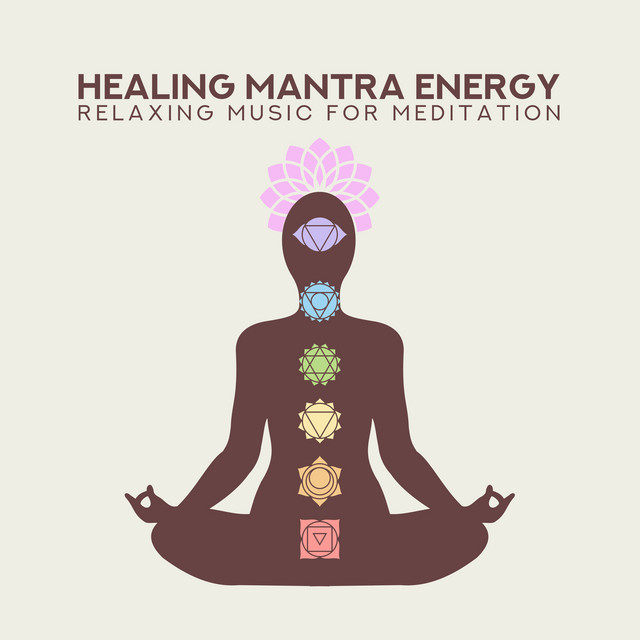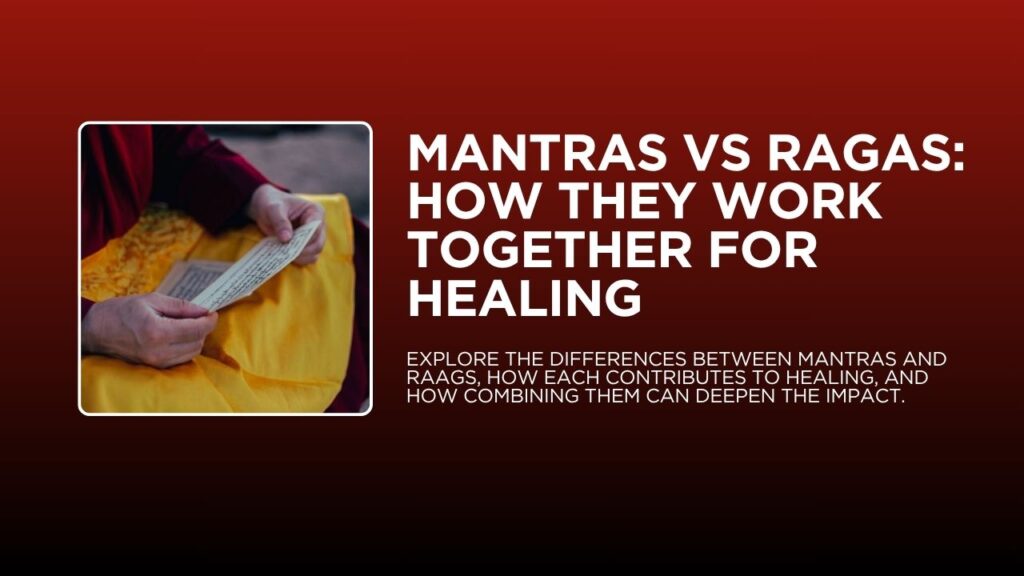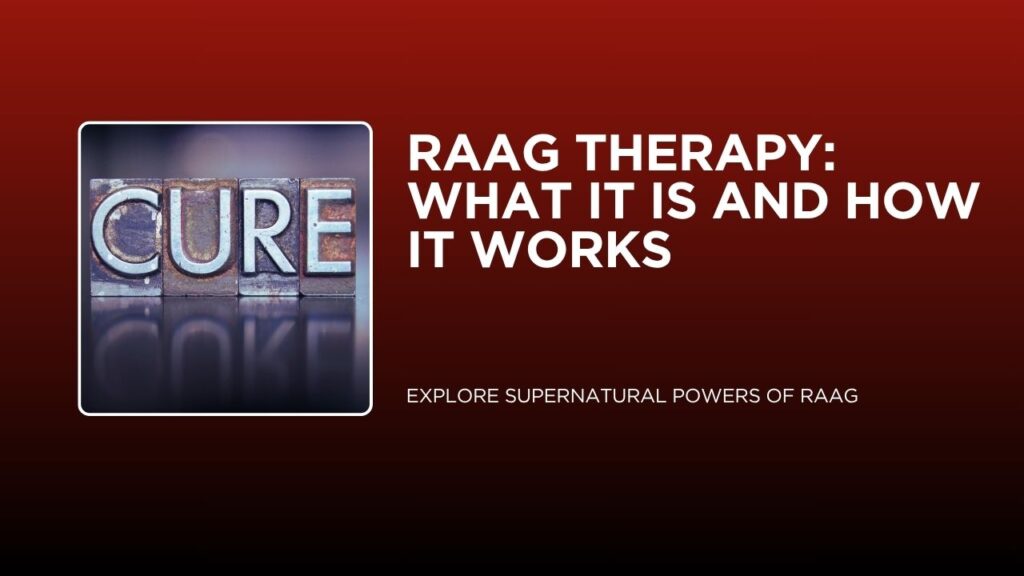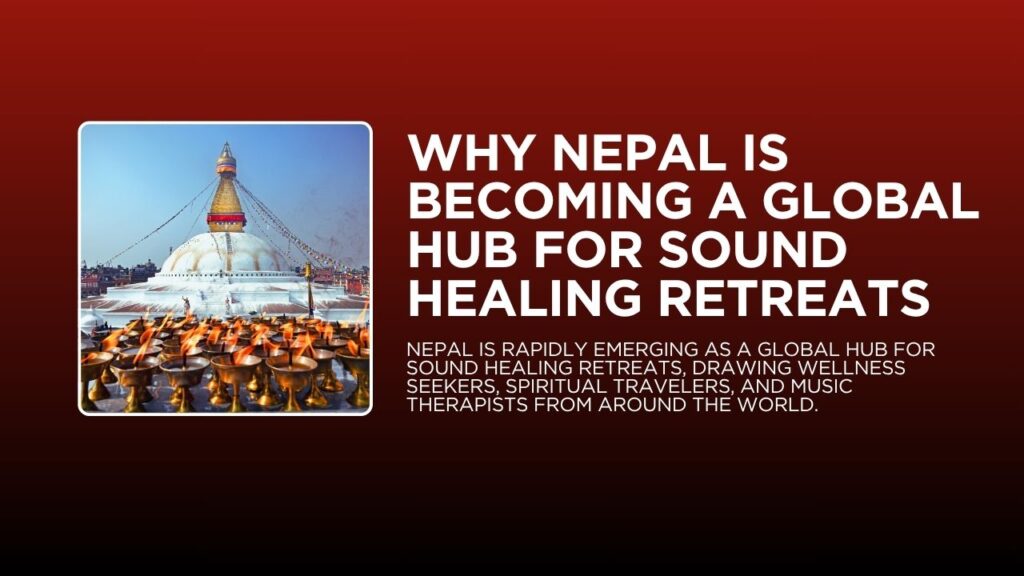In the world of sound-based wellness, two powerful tools have stood the test of time Mantras and Ragas for Healing. These ancient sonic practices from Indian spiritual and musical traditions offer unique yet complementary paths to emotional, mental, and energetic well-being. While both use sound as a medium, their approach, purpose, and effects differ significantly.
Here, we explore the differences between mantras and ragas, how each contributes to healing, and how combining them can deepen the impact. If you’re looking to bring balance to your inner world, understanding mantras and ragas for healing can be your first step.
What Are Mantras
Mantras are sacred sound syllables or phrases chanted repeatedly to focus the mind, invoke divine energies, and purify one’s inner space. Found in Vedic texts and yogic traditions, mantras such as Om, Gayatri Mantra, and Mahamrityunjaya Mantra are believed to carry vibrational codes that connect the practitioner to higher states of consciousness.
Mantras are like a musical hug for your soul—an ancient practice that uses sound to heal, uplift, and connect. By rhythmically repeating sacred syllables, you tap into the powerful vibrations of sound, aligning with your higher self and the universal energy around you. This isn’t just about chanting; it’s about creating harmony within. For those with a high air element in their birth chart or a Vata dosha imbalance, mantras can work wonders, grounding restless energy and bringing calm to the mind.
Mantras, Creative Expression, and Healing

What do the ear and the voice have to do with our health? A lot more than you would expect! Developing our ears and our voice in simple ways can have real and lasting effects on our health and happiness. In many parts of the Western world, there is a rapidly growing awareness of sacred sound, including the Yoga of Sound, a tradition within Indian spirituality that has been in existence for many millennia
Sound is also a medium for yoga, a means by which the goals of yoga can be realized. Furthermore, improved health and spiritual enlightenment can be attained through a deeper understanding of the inclusion of sound in our spiritual practice. With this in mind, not only can yogi practitioners benefit from such an inclusion, but non-yogis, too, since neither postures nor stretches are necessary to tap the goals of yoga through the medium of sacred sound. Yoga postures, however, can exponentially enhance the effects of sacred sound.
Today, there is a widespread interest in chanting within the American yoga community. Mantra chanting and kirtan (call-and-response chanting) have become forms of spiritual expression that bring practitioners together and transform yoga studios into places of worship. While celebrating the experience of yoga in sound and music is important for community building, yoga is also the type of practice that we also cultivate in private. There are aspects of sacred sound that should be known, understood, and applied in that context, and this understanding can be gleaned from the Yoga of Sound, also known as Nada Yoga, a path that is more than two thousand years old. According to yoga scholar Georg Feuerstein, the Yoga of Sound teachings might have influenced Patanjali, the father of classical yoga.
Chant has long been used in cultures around the world for healing and tapping deep spiritual states. Shamanism, for instance, has used sound as its primary means to change the consciousness of a person who is ill into someone who is free of illness. And Benedictine monks have chanted for 1,500 years for their spiritual well-being, without realizing that the benefits were physical and mental as well. When one Benedictine community in France cut out chanting from their daily schedule, the monks who had worked hard on the land for decades started to fall ill. This was rectified the moment that chant was reintroduced by the renowned physician Alfred Tomatis, who was called in to treat the monks. Tomatis has contributed immeasurably to our understanding of the relationship of the ear and the voice to our health.
The Role of Creativity in the Use of Sacred Sound and Mantra
Creativity is in itself a form of healing. Mantras, too, are a form of healing. How, then, do we bring the two together—mantras and creativity?
Health is not simply the absence of disease: It is a condition of soul that invigorates our being, enabling us to derive the most from life. Additionally, the effects of yoga as well as sound vibrations upon our health and well-being have garnered enormous credibility in recent decades. What if we could combine the two to bring about wholeness? That’s the idea behind the Yoga of Sound, a tradition of sacred sound that intersects intimately with the development of yoga in Indian spirituality. The Yoga of Sound embraces it all—mantras, kirtans, and more. Although it should be noted that this tradition, in its most ancient form, was more about listening and attunement to subtle sounds than about making sounds or using mantras.
Mantras, primarily, were not designed to be expressed creatively, at least not in the way they are presently being set to music in the West. One common misconception is that kirtan and mantra are the same thing. Kirtan, generally, is not a mantra. Nor is kirtan a mantra set to music, as commonly assumed. Mantras, for the most part, are not sung, but uttered, muttered, whispered, or recited mentally. If chanted aloud, only a few musical tones are utilized. Nevertheless, certain types of mantras do lend themselves to creative expression.
The first thing that most people say about mantras is that they are meant to be repeated. This is true of a certain type of mantra but not all. Many mantras function like magical spells. They only need to be uttered once. And there is a tremendous effect as a result, much like in a Harry Potter book. Obviously, the effect of such mantras lie in their proper utterance, which is why wizard apprentices (and mantra apprentices) go to school: Hogwarts for the former, a Veda Patashala, or Vedic mantra school, for the latter. Proper mantra study, traditionally, took 12 years.
There is another category of mantras—those deriving from the Tantric tradition. Some of these mantras lend themselves to creativity, especially for the Western musician. This is usually the type of mantra that is repeated in order to “release” the effect progressively. The Tantric tradition, however, is rather secretive, and its mantras are taught only through initiation. The mantras that most lend themselves to creativity are mantras from the Bhakti tradition, “bhakti” meaning devotion. These are also known as “puranic” mantras. They are the names of gods and goddesses that often contain important characteristics of these deities and preserve the sacred stories around these deities. Before you launch into mantras and creativity, a general rule of thumb is to know which category a mantra belongs in before getting creative with it, since there are rules that govern mantras and, in many contexts, ignoring these rules constitutes disrespect, even sacrilege.
Ways to Work Creatively with Devotional Mantras
There are several ways in which devotional mantras can be expressed creatively. First, there is the method of using just a few tones. For instance, with the classic mantra “Om Namah Shiva ya,” you can use a base tone (not “bass” tone, mind you) as your reference, and this could be any tone or pitch you want it to be. Simply by varying the pitch on the syllables of the mantra, even just one or two other tones, you can be quite creative. This is also the easiest form of creativity with a mantra, which pretty much anyone can enjoy playing with, and it helps the mantra come alive. When a mantra “comes alive,” its energy and potency increase exponentially. And you can do this with or without rhythm, letting it flow any way you want without being constrained by tempo.
Another, slightly more involved approach, but requiring some musical knowledge, is to take a musical scale and use that as a reference to create a melody for the mantra. In Indian music, ragas are usually used for this purpose. Ragas are a sequence of musical intervals governed by specific rules. They can also relate to the time of day and season of the year. Western musical scales are not as involved as ragas, but just as good to create a mood of sadness or joy with the basic major or minor scale options. In this way, a mantra may be used to relieve us of painful energies and memories or to evoke joy and delight. Such expressions of our creativity then become a means of healing. In other words, mantras can combine with music to create a harmonic result.
There is, finally, the rhythmic aspect. Mantras in general are rhythmic because they are constructed in meter, like poetry. A natural rhythm occurs in their syllabic structure which can be further developed into more complicated rhythms by the creative musician. However, non-musicians can just as easily tap the rhythmic nature of mantras, and through the rhythm tap their healing potency. For instance, with the classic mantra “Sri Rama Jaya Jaya Rama,” there is rhythm built into the natural flow of the syllables. Say it aloud and you will feel it entrain your thought processes, that is, sync them together harmoniously.
Entrainment is one of the reasons why mantras are so powerful, for they harmonize our thought patterns like pendulums moving in union when in proximity to one another. Ancient Hindus were acutely aware of entrainment many millennial ago, and it was documented in the 1600s by Dutch physicist Christiaan Huygens, opening up the possibilities of entrainment to the scientific community. Mantras are a spiritual technology that inherently possess the power to entrain and, in doing so, to facilitate healing of mind and body.
How Do Healing Mantras Work?
- Vibration and Resonance: Our bodies and the universe are made of energy. Healing mantras tap into specific healing frequencies that resonate within us, promoting balance and harmony on a physical, mental, and spiritual level.
- Focus and Mindfulness: Mantra chanting quiets a busy mind, replacing chaotic thoughts with intentional focus. This meditative practice creates space for both stress relief and self-healing.
- Power of Affirmations: Many mantras contain positive affirmations. Repeating these affirmations rewires our thought patterns, cultivating inner peace and personal transformation.
Top 10 Healing Mantras
- Om (Aum): The most fundamental and powerful of Sanskrit mantras, Om is the primordial sound of the universe. It helps connect us to our true nature and is said to balance the chakras.
- Om Shanti Shanti Shanti: This translates to “Peace, peace, peace.” Perfect for cultivating inner harmony, it is a plea for peace within oneself, with others, and with the world.
- Lokah Samastah Sukhino Bhavantu: This beautiful mantra means “May all beings everywhere be happy and free.” It promotes compassion, reminding us of our interconnectedness and expanding our healing intentions beyond ourselves.
- Om Gam Ganapataye Namaha: This mantra honors Ganesha, remover of obstacles. Chant it to break through internal blockages, attract abundance, and pave the way for new beginnings.
- Ra Ma Da Sa Sa Say So Hung: Known as the Siri Gaitri Mantra, this potent chant is multifaceted. It’s used for deep healing, promoting relaxation, and fostering a connection to the divine.
- Om Namah Shivaya: This mantra honors Shiva, a powerful Hindu deity associated with transformation. It’s chanted to dissolve negativity, promote inner strength, and connect with the divine source.
- Sat Nam: Meaning “Truth is my identity,” this mantra fosters self-realization, authenticity, and connection to one’s higher purpose.
- Om Mani Padme Hum: A beloved Buddhist mantra of compassion, loosely translated as “Hail to the jewel in the lotus.” It promotes compassion, wisdom, and purification.
- Gate Gate Paragate Parasamgate Bodhi Svaha: This Heart Sutra mantra is about transcendence and moving beyond suffering into enlightenment.
- So Hum (or Ham Sa): Translates to “I am That.” It cultivates a sense of oneness with the universe and promotes self-acceptance.
How to Use Healing Mantras
- Find a quiet Space: Minimize distractions to focus on the sound and feel the vibrations.
- Be Comfortable: Sit in a relaxed position that supports easy breathing.
- Set an Intention: What do you want to cultivate with your practice – peace, healing, clarity?
- Repetition is Key: Chant the mantra either out loud or silently to yourself, focusing on its sound and meaning.
- Daily Practice: Even a few minutes each day of mindful mantra chanting can lead to profound benefits.
What Are Ragas?
Ragas are melodic frameworks in Indian classical music designed to evoke specific emotional states and balance the listener’s inner energy. Each raga is associated with a time of day, a mood (rasa), and a set of notes that gently align the listener with natural rhythms.
In Sanskrit, a Raga means “something that colors your mind.” Within Indian classical musical systems, a Raga has the power to create very specific emotions in one’s mind. A range of emotions such as joy, sadness, happiness, romance, yearning, devotion, and more can be expressed through Ragas. Some Ragas are seasonal; they enhance the listener’s mood through association with a particular season, such as spring or monsoon.
Ancient scriptures define a Raga as a composition of sounds capable of bringing joy to the human heart while attaining beauty through specific movements of notes and phrases.
Raga: Music for Healing
Music’s history and connection to humanity date back to the beginning of time. Ancient civilisations used music to communicate with their gods and nature as a healing tool. Today, music therapy is increasingly being used to treat physical and mental issues in a stressed-out world.
Raga therapy, utilizing the healing properties of Indian classical music, involves carefully selected ragas (melodic frameworks) to address various ailments, particularly mental and emotional ones. Ragas are chosen based on their distinct sonic qualities and their ability to resonate with specific emotional states, influencing the listener’s physical and mental well-being.
For a detailed inspection of the raga music for healing you can reach here……
Mantras and Ragas for Healing: A Powerful Combination
While mantras work through repetition and spiritual intention, ragas operate through melody, emotion, and timing. When used together, mantras and ragas for healing can provide an integrated experience of vibration, intention, and mood transformation.Ragas and mantras are fundamentally different. Mantras do have a universal healing effect because they cross the limit of individuality. The spiritual effect of the mantras is undifferentiated and non-specific and they address the illness common to the entire humanity – which is identifying oneself as individual body-mind. Mantras help transcend this limit and help us connect with the universal spirit.
Ragas, or melodies of the Indian classical music, are wordless, pure sounds. Unlike mantras, ragas on the other hand, have an individual effect. This means that ragas address the innate pattern of the individual. That is why different melodies or ragas match different states of people. Ragas help heal our individual patterns of expressing disease states and in this task, they are better suited than mantras. One aspect of the ragas is that they allow the mind to become silent and meditative. When a raga is rendered in a melodious style, it cancels out all the chatter and noises and allows the mind to get focused.
Apart from ragas, music has other aspects too. One aspect of music is that it can bring a community together. Group singing of bhajans, choirs etc. are an example. Group singing is done all over the world, in all cultures. It brings people together, helps dissolve the individual identities and help people connect with the group identity. Another great aspect of music is rhythm. It is used in group drumming when a large number of people can come together and get beyond the individual identities. They can become one with the rhythm.
Movement – communal dance – serves the same purpose. By moving to individual rhythm, one can connect with the universe. In our experiment, we found that rhythm is the common connecting thread between people and universe. Everything has a rhythm…waves of the ocean, trot of a horse, beat of a heart, revolution of the earth, cycles and seasons, day and night, flapping of a bird’s wings, the angular movement of fish – all of these and everything else in nature is rhythmic. When we play a specific beat, ask people to shut their eyes and move to the rhythm, they shape shift into anything! They become a horse, a cloud, a flower, a wave….rhythm can be common to them and to something in nature. They experience unification with the universe through rhythm and they feel oneness with all creation. The spectrum of music is very large. We can specifically use music ragas for healing. Along with movement, art, and meditation, we are offering music as a tool of healing at our retreat center.
Comparison Table: Mantras vs Ragas for Healing
| Feature | Mantras | Ragas |
|---|---|---|
| Origin | Vedas, Upanishads, Tantra | Indian Classical Music (Dhrupad, Hindustani, Carnatic) |
| Form | Sound syllables, words, or verses | Melodic frameworks with specific notes |
| Main Focus | Vibration, breath, repetition | Emotional expression, timing, tonal purity |
| Healing Method | Through intention, resonance, and breath | Through mood (rasa), timing, and melodic swaras |
| Use in Practice | Japa (repetition), meditation, prayer | Listening, singing, instrumental therapy |
| Chakra Activation | Through bija (seed) sounds and focused repetition | Through note emphasis (Sa to Ni) and raga structure |
| Scientific Effect | Reduces cortisol, lowers heart rate, calms mind | Balances brain hemispheres, stabilizes mood |
| Combination Potential | Used with pranayama or ragas for enhanced effect | Combined with mantras for spiritual healing |
Popular Pairings of Mantras and Ragas for Healing
| Mantra | Recommended Raga | Healing Effect |
|---|---|---|
| Om (Universal sound) | Raga Yaman | Peace, cosmic connection |
| Gayatri Mantra | Raga Ahir Bhairav | Clarity, wisdom, balance |
| Mahamrityunjaya Mantra | Raga Darbari Kanada | Release, surrender, emotional strength |
| Om Namah Shivaya | Raga Malkauns | Grounding, spiritual power, fear release |
| So-Ham (Breath mantra) | Raga Bhimpalasi | Self-awareness, emotional openness |
Final Thoughts: Mantras and Ragas for Healing Are Sound Medicine
In a world overwhelmed by noise, distraction, and disconnection, mantras and ragas for healing offer a natural, timeless remedy. Mantras connect us to higher vibrations through sound and intention, while ragas align our emotional field through melody and mood. When practiced together, they become a synergistic force of sound medicine, deeply rooted in spiritual and musical heritage.




Pingback: What is the Sonic Alignment Technique? A Practise to align mind and body - Manasukh Dhvani